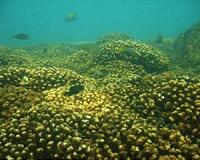| . |  |
. |
Washington DC (SPX) Apr 08, 2011 Concentrated waste plumes from fish farms could travel significant distances to reach coastlines, according to a study to be published in an upcoming issue of the journal Environmental Fluid Mechanics, available online now. Roz Naylor, Oliver Fringer and Jeffrey Koseff of the Woods Institute for the Environment at Stanford University found that relatively high concentrations of dissolved waste from fish pens do not consistently dilute immediately. The paper is the first detailed look at how 'real world' variables, such as tides, currents, the earth's rotation and the physical structure of the pens themselves, influence the flow of waste from fish farms. The research, which was funded by the Lenfest Ocean Program, can serve as an important tool for determining the impacts of aquaculture discharge on waterways and surrounding shorelines. "This study suggests that we should not simply assume 'dilution is the solution' for aquaculture pollution," said Koseff. "We discovered that the natural environment around fish pens can dramatically affect how far waste plumes travel from the source." Dissolved substances from feces, undigested food and other forms of discharge amass near fish pens. In multiple modeling scenarios in which these factors were varied to study how each one affected the behavior of such pollution, effluent was characterized by "plumes" of highly concentrated waste that held together for great distances from the source. The findings suggest that regulators need to consider the full range of possible influences on the movement of pollution plumes-and accurately identify the dominant factors-when designing water quality regulations for and monitoring waste from aquaculture. "Our approach to aquaculture is at an important juncture right now," said Naylor, referring to the fact that the National Oceanic and Atmospheric Administration is inviting public comments through April 11 on its draft national aquaculture policy, and the state of California is implementing new aquaculture regulations. "As the aquaculture industry grows, so will the number of pens that create pollution," she added. "The models that we developed for this study can help regulators determine how waste from proposed fish farms might impact the waterways and coastlines both near and far from the pens." Read the full study from Environmental Fluid Mechanics.
Share This Article With Planet Earth
Related Links Lenfest Ocean Program Water News - Science, Technology and Politics
 World's Reef Fishes Tussling With Human Overpopulation
World's Reef Fishes Tussling With Human OverpopulationHalifax, Canada (SPX) Apr 07, 2011 In an unprecedented collaborative analysis published in the journal PLoS Biology, scientists from 49 nations demonstrated that the ability of reef fish systems to produce goods and services to humanity increases rapidly with the number of species. However, growing human populations hamper the ability of reefs to function normally, and counterintuitively, the most diverse reef fish systems suffer ... read more |
|
| The content herein, unless otherwise known to be public domain, are Copyright 1995-2010 - SpaceDaily. AFP and UPI Wire Stories are copyright Agence France-Presse and United Press International. ESA Portal Reports are copyright European Space Agency. All NASA sourced material is public domain. Additional copyrights may apply in whole or part to other bona fide parties. Advertising does not imply endorsement,agreement or approval of any opinions, statements or information provided by SpaceDaily on any Web page published or hosted by SpaceDaily. Privacy Statement |